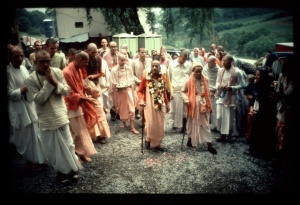CC Adi 10.19 (1975): Difference between revisions
(Vanibot #0027: CCMirror - Mirror CC's 1996 edition to form a basis for 1975) |
(Vanibot #0020: VersionCompareLinker - added a link to the Version Compare feature) |
||
| Line 2: | Line 2: | ||
<div style="float:left">'''[[Sri Caitanya-caritamrta (1975)|Śrī Caitanya-caritāmṛta (1975)]] - [[CC Adi (1975)|Ādi-līlā]] - [[CC Adi 10 (1975)|Chapter 10: The Trunk, Branches and Subbranches of the Caitanya Tree]]'''</div> | <div style="float:left">'''[[Sri Caitanya-caritamrta (1975)|Śrī Caitanya-caritāmṛta (1975)]] - [[CC Adi (1975)|Ādi-līlā]] - [[CC Adi 10 (1975)|Chapter 10: The Trunk, Branches and Subbranches of the Caitanya Tree]]'''</div> | ||
<div style="float:right">[[File:Go-previous.png|link=CC Adi 10.18 (1975)|Ādi-līlā 10.18]] '''[[CC Adi 10.18 (1975)|Ādi-līlā 10.18]] - [[CC Adi 10.20 (1975)|Ādi-līlā 10.20]]''' [[File:Go-next.png|link=CC Adi 10.20 (1975)|Ādi-līlā 10.20]]</div> | <div style="float:right">[[File:Go-previous.png|link=CC Adi 10.18 (1975)|Ādi-līlā 10.18]] '''[[CC Adi 10.18 (1975)|Ādi-līlā 10.18]] - [[CC Adi 10.20 (1975)|Ādi-līlā 10.20]]''' [[File:Go-next.png|link=CC Adi 10.20 (1975)|Ādi-līlā 10.20]]</div> | ||
{{CompareVersions|CC|Adi 10.19|CC 1975|CC 1996}} | |||
{{RandomImage}} | {{RandomImage}} | ||
==== TEXT 19 ==== | ==== TEXT 19 ==== | ||
<div class="verse"> | <div class="verse"> | ||
: | :"daśa-sahasra gandharva more deha' candramukha | ||
:tārā gāya, muñi | :tārā gāya, muñi nācoṅ--tabe mora sukha" | ||
</div> | </div> | ||
| Line 18: | Line 17: | ||
<div class="synonyms"> | <div class="synonyms"> | ||
daśa-sahasra—ten thousand; gandharva—residents of Gandharvaloka; more—unto me; | daśa-sahasra—ten thousand; gandharva—residents of Gandharvaloka; more—unto me; deha'-please deliver; candra-mukha—O moon-faced one; tārā gāya—let them sing; muñi nācoṅ—let me dance; tabe—then; mora—my; sukha—happiness. | ||
</div> | </div> | ||
| Line 25: | Line 24: | ||
<div class="translation"> | <div class="translation"> | ||
"O Candramukha! Please give me ten thousand Gandharvas. Let them sing as I dance, and then I will be greatly happy." | |||
</div> | </div> | ||
Latest revision as of 14:14, 26 January 2020
Śrī Caitanya-caritāmṛta (1975) - Ādi-līlā - Chapter 10: The Trunk, Branches and Subbranches of the Caitanya Tree

His Divine Grace
A.C. Bhaktivedanta Swami Prabhupada
A.C. Bhaktivedanta Swami Prabhupada
TEXT 19
- "daśa-sahasra gandharva more deha' candramukha
- tārā gāya, muñi nācoṅ--tabe mora sukha"
SYNONYMS
daśa-sahasra—ten thousand; gandharva—residents of Gandharvaloka; more—unto me; deha'-please deliver; candra-mukha—O moon-faced one; tārā gāya—let them sing; muñi nācoṅ—let me dance; tabe—then; mora—my; sukha—happiness.
TRANSLATION
"O Candramukha! Please give me ten thousand Gandharvas. Let them sing as I dance, and then I will be greatly happy."
PURPORT
The Gandharvas, who are residents of Gandharvaloka, are celebrated as celestial singers. Whenever singing is needed in the celestial planets, the Gandharvas are invited to sing. The Gandharvas can sing continuously for days, and therefore Vakreśvara Paṇḍita wanted to dance as they sang.